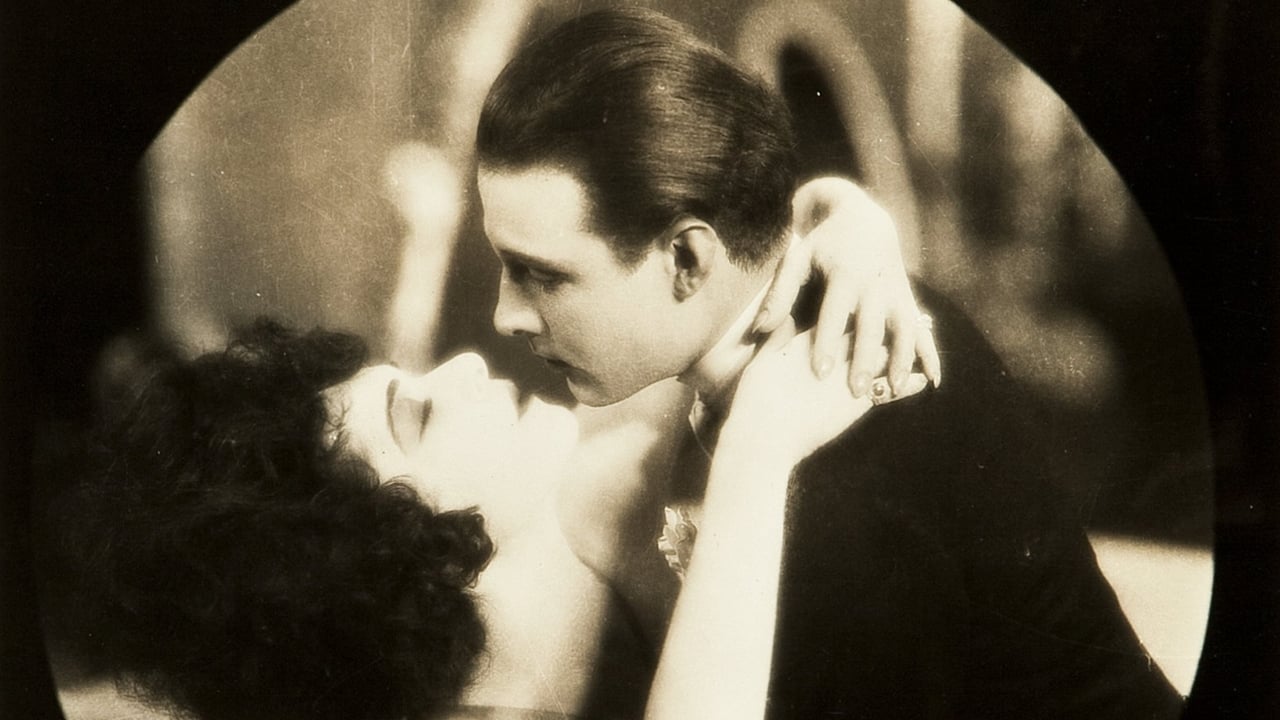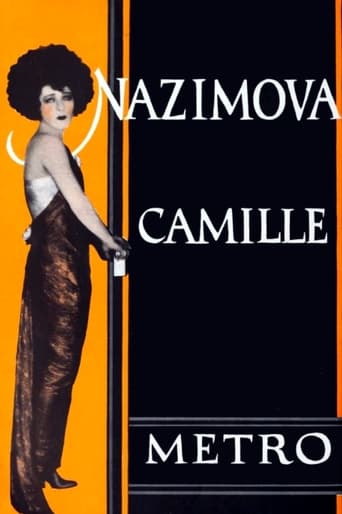



What makes it different from others?
Am I Missing Something?
I think this is a new genre that they're all sort of working their way through it and haven't got all the kinks worked out yet but it's a genre that works for me.
View MoreExcellent and certainly provocative... If nothing else, the film is a real conversation starter.
View MoreThe novel by Alexandre Dumas fils has been brought to the screen on numerous occasions and, indeed, a 'magic conjuring of players' have portrayed Marguerite Gautier, including the venerable Sarah Bernhardt. Since George Cukor's CAMILLE with Greta Garbo and Robert Taylor won innumerable appraisals among varied audiences, it has become the most popular adaptation. No doubt, 'beautiful' is an epithet that appears to be somehow inseparable from that glamorous movie. A nice surprise, however, is this silent version of the story which we can see in its restored incarnation attached to the DVD release of 1936 CAMILLE.Since Giuseppe Verdi adapted the story to the needs of his sublime music, here, the drama of 'the Lady of the Camellias' and 'Daughter of Chance' is perceived and interpreted entirely from the perspective of the early 1920s. 1921 undeniably saw the rise of the medium and the rapid progress of its various dimensions. What evokes from the movie most importantly is the fact that it relies primarily upon women: their creative contributions, their interpretations and liberties taken with the original literary source. That is exceptionally unique and innovative for the period when studio systems were at their dawn, true acting skills and executions of certain themes not still that restrained nor condensed but commercial targets were close to gain sovereign control. The content along with the protagonists' 'little escapades' where sweetness of romance turns into bitterness of lonely memories is sole subtlety. Highly influenced by 'oval' symbols --- circles of life --- the circle of the year, four seasons clearly divide the storyline into different phases and appear to represent the emotional undertones of the character. Winter and snowfall along with Marguerite's weak health and painful past; spring and its blossoming trees along with new hope and the love as the greatest doctor; summer and warmed schemes along with breakthrough decisions and sacrifices; autumn and the Hazard D'Or along with a new 'golden beauty' and a tricky web that inevitably leads to the tragic climax larger than life and honor. The dying year that passes away along with the heroine who calls herself a 'useless ornament, a plaything, a momentary aurora' touched by the only jewel put in her heart: love. There is poetry and subtlety in this circle and the continuity in remaining aspects of chivalric undertones (in reference to Manon Lescaut). Great credit to June Mathis for the scenario and Natacha Rambova for the art deco! Some film scholars labeled Rambova's set designing as 'impressionistic' but I think one can say something more direct: Rambova felt free to express herself through art opening, in this way, the door to wonderful opportunities for female producers and their diverse fantasies. And the lead? Alla Nazimova, or just NAZIMOVA (as she appears in the credits), who is probably most famous for her bizarre interpretation in SALOME, portrays the character of Marguerite Gautier from a completely innovative angle. She appears to hold the jewel of her art in her hand lacking 'debilitating compromise' (similarly to Sarah Bernhardt, Zarah Leander, Greta Garbo). She is the woman of her times and the heroine that the 1921 audiences could perfectly identify with. Having studied Stanislavski's system in Russia where the most significant part of acting was a performer's emotional memory, she proves to have incorporated this highly humane and artistic method to Hollywood (similarly to the director Rouben Mamoulian a decade later). She steals the attention in her scenes by developing her character whilst acting it; she seems to acquire certain emotional states of the protagonist as the storyline develops. Her performance is varied reaching its climax near the finale. In some scenes, particularly at the beginning, she marks certain moments of interest as a strong, sophisticated woman not afraid of reveling some homo erotic signals in the scene with Nichette (Patsy Ruth Miller). Later, as life offers her character something unexpected and promising, she changes into a more dramatic, melancholic yet illumined personality. In the scenes with Rudolph Valentino (initially to the period of the hysterical mania begun with his first smashing success, THE FOUR HORSEMEN OF THE APOCALYPSE), she highlights this inner transformation from a 'plaything' to a 'devoted camellia.' Humorously, Armand would do better to study love than law with her... Valentino is adequate but not particularly outstanding. He relies upon handsome charm to flatter the eyes of women while Nazimova relies upon truly sophisticated skills. These strengths that Nazimova contributes to the movie are worth studying and make this silent film worth considering. Additionally, they beautifully address female viewers in various dimensions.The supporting cast are rarely mentioned in many reviews and undeservedly so. Why? Firstly, William Orlamond makes for a captivating Monsieur Duvall by highlighting the character's traditional concept of honor, inheritance, certain 'idea' of happiness for his children. Secondly, Zeffie Tillbury is accurate as Prudence underlining the character's major striking features. Finally, a note should be made of actress and singer Consuelo Flowerton, the mother of Nina Foch (1924-2008), the actress and teacher at USC School of Cinematic Arts. Just a single scene where Ms Flowerton appears but a truly memorable one...Consider her charming costume...This 70 minute-long silent film is well worth seeking out as a lovely contribution that creative women of the period had made within the medium. If it is not enough for you to merely hear about the stars of yore, particularly about the silent celebrities like Nazimova but you are looking for some of their memorable productions, CAMILLE is truly one of such. Not long, interesting, visually exquisite and supplied with vibrant music score by Peter Vantine. 8/10
View MoreThe only things separating Nazimova's "Camille" from being an experimental art film -- which her later "Salome" certainly is -- is that it tells a conventional story and uses only minimal special effects. In a purely cinematic sense, "Camille" is quite conventional. Director Ray Smallwood had worked on Nazimova's last couple of previous productions and was mainly there just to help Nazimova make the picture that she wanted; his career would not long outlast "Camille." The titles, written by June Mathis, are terribly overwrought and consist of the most pungent and overripe lines from "Camille"'s source play, a style completely inconsistent from Mathis' usual work. And yet that too would have been what Nazimova wanted. Rudolph Valentino, looking a little out of sorts playing the seduced, rather than the seducer, also turns in the performance that Nazimova needs, and present company doesn't think it among his best, though he looks great.Nevertheless, there are lots of reasons to see this picture. Natacha Rambova's eye-popping sets are a sight to behold and actually take the picture to a higher level of experience than it would have been had a more typical set dressing -- even in a modernized version of this story, which this is -- been employed. Nazimova's portrayal of Dumas' ill-fated "Lady of the Camellias" is strange and to some degree alien, but it's a matter of style over substance, a phrase that describes this whole project. The 1936 Garbo version is more like a conventional adaptation of the property, but in 1921 Nazimova didn't want to do that -- she had her own sensational and imaginative vision of how to realize this story, and that is what she went with. While "Camille" is executed in a conventional way, the film itself is not conventional; it's more like a feverish dream about "Camille." Until the last third of the picture, Nazimova's portrayal is energetic and, at times, almost frenetic, her ultra-big big hair and wildly elaborate costume nearly upstaging her own Stanislavkïan acting ability. It is often said that this film was a commercial failure, but it wasn't; the presence of Valentino and its predictable story structure was enough to sell it to a public -- alas for Nazimova -- mainly interested in Valentino alone. "Camille" may not be as enthralling as "Salome", but it is a remarkable experience on its own terms, and as it runs just over an hour, even those not so well inclined towards the property as it unfolds will not have to wait long for it to be done.
View MoreNazimova truly is a creature like none other. Though born in the 1870's she is not of the nineteenth century nor of the roaring twenties. With her choppy afro and willowyeven anorexicbody, if she suggests any period at all, it is maybe the Andy Warhol disco seventies. But she's definitely watchable in this movie, even touchingshe has a rather cherubic face under her bizarre hairstyle which makes her believable as Camille, the dying courtesan whose last chance at happiness is destroyed when the father of her lover Armand Duval demands that she give him up. Armand, played by Rudolph Valentino, allegedly had much of his role reduced by Nazimova who could recognize a fellow scene stealer when she saw one (he is replaced by a book in the deathbed scene!), but he manages to make his impassioned, surly presence felt. Falling as quickly into resentment as he earlier did into love when he believes Nazimova has tired of him, he comes across as both sympathetic and shallow (and quite funny in the casino scenes when he tries a bit too hard to make Camille jealous by flirting with an unworthy tootsie who resembles Mae West). The art deco set design that still looks contemporary almost constitutes a character in itself.
View MoreSpoilers follow.The summary is more appropriate to the inferior Greta Garbo version of Camille where the film is given a Hollywood-style happy ending. In that version Marguerite dies, but reunited with her lover Armand, and in his arms. Marguerite's illness is also down played throughout the film, presumably not to harm GG's beautiful image.The Nazimova version is a true tragedy. We know she is fatally ill from the first scene. Her consumption can be seen as symbolic - when the original story "La Dame aux camelias" was written consumption was known as the love disease. Sufferers waste away like doomed lovers, and as they lost weight, took on a pale beauty.To Marguerite, her love for Armand is a way out of her sordid way of life. But when she becomes aware of what her love is doing to Armand, she gives up her hopes of happiness in order that Armand can have a normal future without being dragged down by her past. She dies believing Armand now despises her for leaving him for her previous rich protector, unaware that Armand has ever discovered the truth about her motives. Clutching the book "Manon Lescaut" that Armand gave her, and which is so symbolic in their relationship, her last words are "let me sleep and dream".A superb and timeless film.
View More